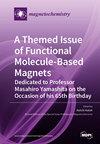Novel Tetranuclear Heterometallic Mn3Ni and Mononuclear Ni Complexes with an ONO Schiff Base Ligand: Synthesis, Crystal Structures, and Magnetic Properties
IF 2.5
4区 化学
Q2 CHEMISTRY, INORGANIC & NUCLEAR
引用次数: 0
Abstract
A mononuclear Ni(II) complex, [Ni(HL1)2], (1) and a novel tetranuclear heterometal Mn-Ni complex, [Mn3Ni(L1)4Cl2(EtOH)2], (2) [H2L1 = N-(2-hydroxymethylphenyl)salicylideneimine], have been synthesized and characterized via X-ray crystal structure analyses, infrared spectra, and elemental analyses. The structure analyses revealed that the tridentate ligand, H2L1, coordinates in a facial mode for Ni and a mer mode for Mn, respectively. Complex 2 includes Mn(II)Mn(III)2Ni(II) tetranuclear metal core bridged by μ-phenoxo and μ-alkoxo oxygens. Magnetic measurements for 2 indicate that weak ferromagnetic interactions (JMn(III)Ni(II) = 2.23, JMn(III)Mn(II) = 0.46, JMn(II)Ni(II) = 1.78, and JMn(III)Mn(III) = 0.58 cm−1) dominate in the tetranuclear core. Additionally, in alternating current (AC) magnetic measurements, frequency-dependent out-of-phase responses were observed.带有ONO席夫碱配体的新型四核异金属Mn3Ni和单核Ni配合物:合成、晶体结构和磁性能
合成了一种单核Ni(II)配合物[Ni(HL1)2],(1)和一种新型四核异金属Mn-Ni配合物[Mn3Ni(L1)4Cl2(EtOH)2], (2) [H2L1 = N-(2-羟甲基苯基)水杨基亚胺],并通过x射线晶体结构分析、红外光谱和元素分析对其进行了表征。结构分析表明,三叉戟配体H2L1对Ni和Mn分别为面模和聚合物模。配合物2包括Mn(II)Mn(III)2Ni(II)四核金属芯,由μ-苯氧基和μ-烷氧基氧基氧桥接。2的磁性测量表明,弱铁磁相互作用(JMn(III)Ni(II) = 2.23, JMn(III)Mn(II) = 0.46, JMn(II)Ni(II) = 1.78, JMn(III)Mn(III) = 0.58 cm−1)在四核核心中占主导地位。此外,在交流(AC)磁测量中,观察到频率相关的相外响应。
本文章由计算机程序翻译,如有差异,请以英文原文为准。
求助全文
约1分钟内获得全文
求助全文
来源期刊

Magnetochemistry
Chemistry-Chemistry (miscellaneous)
CiteScore
3.90
自引率
11.10%
发文量
145
审稿时长
11 weeks
期刊介绍:
Magnetochemistry (ISSN 2312-7481) is a unique international, scientific open access journal on molecular magnetism, the relationship between chemical structure and magnetism and magnetic materials. Magnetochemistry publishes research articles, short communications and reviews. Our aim is to encourage scientists to publish their experimental and theoretical results in as much detail as possible. Therefore, there is no restriction on the length of the papers. The full experimental details must be provided so that the results can be reproduced.
 求助内容:
求助内容: 应助结果提醒方式:
应助结果提醒方式:


